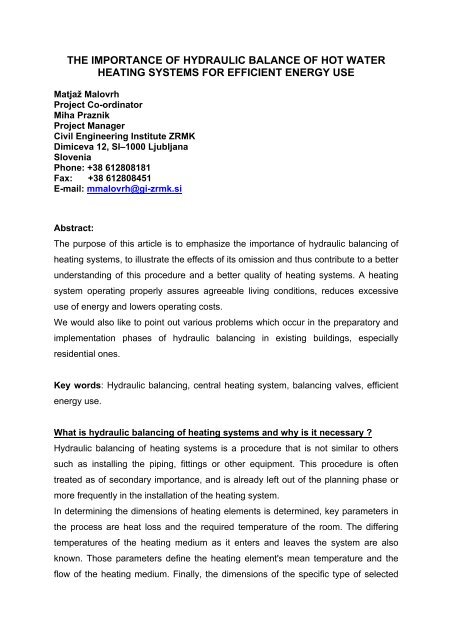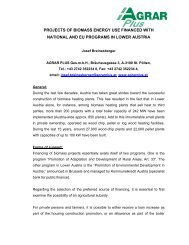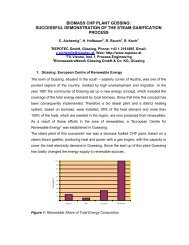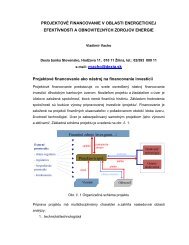The importance of hydraulic balance of hot water heating systems ...
The importance of hydraulic balance of hot water heating systems ...
The importance of hydraulic balance of hot water heating systems ...
You also want an ePaper? Increase the reach of your titles
YUMPU automatically turns print PDFs into web optimized ePapers that Google loves.
THE IMPORTANCE OF HYDRAULIC BALANCE OF HOT WATER<br />
HEATING SYSTEMS FOR EFFICIENT ENERGY USE<br />
Matjaž Malovrh<br />
Project Co-ordinator<br />
Miha Praznik<br />
Project Manager<br />
Civil Engineering Institute ZRMK<br />
Dimiceva 12, SI–1000 Ljubljana<br />
Slovenia<br />
Phone: +38 612808181<br />
Fax: +38 612808451<br />
E-mail: mmalovrh@gi-zrmk.si<br />
Abstract:<br />
<strong>The</strong> purpose <strong>of</strong> this article is to emphasize the <strong>importance</strong> <strong>of</strong> <strong>hydraulic</strong> balancing <strong>of</strong><br />
<strong>heating</strong> <strong>systems</strong>, to illustrate the effects <strong>of</strong> its omission and thus contribute to a better<br />
understanding <strong>of</strong> this procedure and a better quality <strong>of</strong> <strong>heating</strong> <strong>systems</strong>. A <strong>heating</strong><br />
system operating properly assures agreeable living conditions, reduces excessive<br />
use <strong>of</strong> energy and lowers operating costs.<br />
We would also like to point out various problems which occur in the preparatory and<br />
implementation phases <strong>of</strong> <strong>hydraulic</strong> balancing in existing buildings, especially<br />
residential ones.<br />
Key words: Hydraulic balancing, central <strong>heating</strong> system, balancing valves, efficient<br />
energy use.<br />
What is <strong>hydraulic</strong> balancing <strong>of</strong> <strong>heating</strong> <strong>systems</strong> and why is it necessary ?<br />
Hydraulic balancing <strong>of</strong> <strong>heating</strong> <strong>systems</strong> is a procedure that is not similar to others<br />
such as installing the piping, fittings or other equipment. This procedure is <strong>of</strong>ten<br />
treated as <strong>of</strong> secondary <strong>importance</strong>, and is already left out <strong>of</strong> the planning phase or<br />
more frequently in the installation <strong>of</strong> the <strong>heating</strong> system.<br />
In determining the dimensions <strong>of</strong> <strong>heating</strong> elements is determined, key parameters in<br />
the process are heat loss and the required temperature <strong>of</strong> the room. <strong>The</strong> differing<br />
temperatures <strong>of</strong> the <strong>heating</strong> medium as it enters and leaves the system are also<br />
known. Those parameters define the <strong>heating</strong> element's mean temperature and the<br />
flow <strong>of</strong> the <strong>heating</strong> medium. Finally, the dimensions <strong>of</strong> the specific type <strong>of</strong> selected
<strong>heating</strong> element are determined according to the manufacturer's data, usually<br />
presented in tabular form. All parameters, except the medium flow are more or less<br />
accurate.<br />
<strong>The</strong> <strong>heating</strong> medium (<strong>water</strong>) is a carrier <strong>of</strong> the heat. If its flow is insufficient, room<br />
<strong>heating</strong> cannot be satisfactory. What happens in a <strong>heating</strong> element with insufficient<br />
<strong>heating</strong> medium flow? <strong>The</strong> dimensions <strong>of</strong> element are determined according to<br />
parameters such as medium flow, as mentioned before. If the flow is lower than it<br />
was foreseen, the medium is cooler on its return. <strong>The</strong>refore the mean temperature<br />
would be lower and the <strong>heating</strong> element would not be as <strong>hot</strong> as predicted. <strong>The</strong><br />
energy <strong>balance</strong> between the element and the room is established at a lower room<br />
temperature, so the room <strong>heating</strong> is not adequate.<br />
<strong>The</strong> situation is just the opposite when the flow <strong>of</strong> the <strong>heating</strong> medium is higher than<br />
predicted. Experience shows that such cases are usually not the subject <strong>of</strong> resident's<br />
complaints and claims, which are common in the case on lower <strong>heating</strong> medium flow.<br />
Such a problem <strong>of</strong> <strong>hydraulic</strong>ally un<strong>balance</strong>d <strong>heating</strong> <strong>systems</strong> is partially alleviated by<br />
the "benevolence" <strong>of</strong> <strong>heating</strong> elements. <strong>The</strong> interdependence between delivered heat<br />
and a room temperature is not linear, but follows a curve which is steep only at the<br />
start. For example: 100% flow leads to a room temperature <strong>of</strong> 20°C, 75% flow to<br />
18.8°C, 50% flow to 16.7°C, 150% flow to 21.4°C, 200% flow to 22°C. This fact also<br />
results in lower requirements for flow accuracy, usually ±10%.<br />
<strong>The</strong> priority task is to assure an adequate flow for the last <strong>heating</strong> elements in the<br />
system, which are deprived <strong>of</strong> warmth the most. On the other hand, one must ensure<br />
that the flow surplus does not cause over<strong>heating</strong> in nearer rooms. Specifically every<br />
1°C results in higher costs for <strong>heating</strong>, +8% in central Europe or +12% in the case <strong>of</strong><br />
southern Europe.
Consequently, only a <strong>hydraulic</strong>ally <strong>balance</strong>d system ensures a proper feeling <strong>of</strong><br />
comfort and a normal cost for the central <strong>heating</strong>. <strong>The</strong> procedure is clearly <strong>of</strong> vital<br />
<strong>importance</strong> and is therefore necessary. <strong>The</strong> larger the <strong>hot</strong> <strong>water</strong> <strong>heating</strong> system, the<br />
more important is <strong>hydraulic</strong> balancing. <strong>The</strong> project's documentation must define<br />
elements needed, their settings, required measurements and the resulting costs. <strong>The</strong><br />
required technical know-how and equipment are now available, so there are no<br />
objective reasons to neglect <strong>hydraulic</strong> balancing.<br />
<strong>The</strong> negative consequences <strong>of</strong> neglect <strong>of</strong> <strong>hydraulic</strong> balancing are as a rule<br />
proportional to a building's size and take different forms:<br />
- Non-uniform <strong>heating</strong> through a building's height and length. <strong>The</strong> more distant a<br />
room, the more evident the problem.<br />
- Central regulation <strong>of</strong> the system is difficult because the heat flow is not distributed<br />
properly.<br />
- A circulation pump which would otherwise be adequate is insufficient, so it is<br />
replaced with a more powerful one.<br />
- <strong>The</strong> risk <strong>of</strong> noise in the part <strong>of</strong> installation closest to the circulation pump.<br />
- Uneconomic operation <strong>of</strong> the system due to the more powerful circulation pump<br />
and over<strong>heating</strong> <strong>of</strong> part <strong>of</strong> a building.<br />
<strong>The</strong> difference between theory and practice<br />
So it is logical to ask how one could neglect such an important phase <strong>of</strong> the project?<br />
<strong>The</strong> circulation pump causes the flow <strong>of</strong> <strong>heating</strong> medium by creating a difference in<br />
pressure between the inlet and outlet <strong>of</strong> the system. <strong>The</strong> difference is highest at the<br />
beginning <strong>of</strong> the system and lowest at the end <strong>of</strong> the system. <strong>The</strong> longer the branch,<br />
the bigger the deviation in pressure.<br />
<strong>The</strong> required pressure difference for each <strong>heating</strong> element depends on its size,<br />
<strong>heating</strong> medium flow and location in the <strong>heating</strong> system's network. It is necessary<br />
that each element has the right pressure difference, according to it's flow. When<br />
<strong>hydraulic</strong>ally balancing the system, the pressure difference surplus is usually reduced<br />
at all vertical connecting pipes, except on the last, where a surplus doesn't exist. <strong>The</strong><br />
same principle is applied individually to the <strong>heating</strong> elements on the same vertical<br />
connecting pipe.
<strong>The</strong>re was no special equipment for <strong>hydraulic</strong>ally balancing in the past, so the<br />
process was demanding and sometimes almost impossible. This is also the reason,<br />
why planners and installers frequently abandoned the procedure. Attempts to do it<br />
frequently boomeranged in the form <strong>of</strong> complaints and claims due to the lower<br />
temperatures in the most distant rooms.<br />
<strong>The</strong> problem was usually solved by the selection <strong>of</strong> a circulation pump with higher<br />
capacity. This resulted in higher flow in all the <strong>heating</strong> system and also higher<br />
pressure difference, according to the square root <strong>of</strong> flow value. <strong>The</strong> nearer vertical<br />
connections already had a flow surplus, which became even higher. <strong>The</strong> result <strong>of</strong><br />
such a process was over<strong>heating</strong> <strong>of</strong> the nearest rooms and higher electricity<br />
consumption due to the pump operation. Both outcomes needlesslly raise operation<br />
costs and cause inefficient use <strong>of</strong> energy. This fact was usually concealed from<br />
residents, as long as no one felt cold.<br />
It is evident that the problem <strong>of</strong> <strong>hydraulic</strong>al balancing cannot be properly solved just<br />
by installing a larger circulation pump. This way <strong>of</strong> solving the problem is nowadays<br />
less expectable, because the know-how and the equipment are available, e.g. quality<br />
products for balancing the pressure at vertical and horizontal connections, computer<br />
planning, measuring instruments for pressure difference and flow, new methods for<br />
implementig the procedure, etc. In spite <strong>of</strong> this German technical literature reveals<br />
"surprisingly unexpected" statistics: 95% <strong>of</strong> <strong>heating</strong> <strong>systems</strong> are not <strong>hydraulic</strong>ally<br />
<strong>balance</strong>d. Circulation pumps are over-dimensioned by factor <strong>of</strong> 2 to 4! It should also<br />
be mentioned that required power <strong>of</strong> circulation pump grows by the power <strong>of</strong> 3 <strong>of</strong> the<br />
flow increase.<br />
This issue is <strong>of</strong>ten neglected because people think there is no point in <strong>hydraulic</strong>ally<br />
balancing the system if it works without it. <strong>The</strong> other aspect <strong>of</strong> the question (what are<br />
the consequences and who will pay for them?) is naturally missed out.<br />
Pressure difference regulators on the vertical connections<br />
If the system has a constant flow <strong>of</strong> circulating medium (in the case <strong>of</strong> manually<br />
regulated valves), special regulating valves should be installed on the vertical and<br />
horizontal connections to eliminate the flow surplus and thereby <strong>hydraulic</strong>ally<br />
<strong>balance</strong>d them. This technical solution is not appropriate for <strong>systems</strong> with variable<br />
flow, for example, where elements with thermostatic valves are installed.
<strong>The</strong>se are permanent <strong>hydraulic</strong> resistors, where pressure drop varies by the power <strong>of</strong><br />
2 <strong>of</strong> flow change. When reducing the flow <strong>of</strong> the medium, their influence become<br />
insignificant. When selecting thermostatic valves for the system, the pressure<br />
difference on the valve should not exceed 20 to 30 kPa.<br />
Regulating valves with constant resistance cannot provide that, so we need to install<br />
automatic pressure difference regulators on the vertical connections, which maintain<br />
the set value according to the thermostatic valves.<br />
Larger <strong>systems</strong> use a combination <strong>of</strong> both valves. Regulating valves limit the upper<br />
flow value and pressure difference regulators ensure the proper functioning <strong>of</strong> the<br />
thermostatic valves. <strong>The</strong>se regulating elements at the same time allow for additional<br />
functions on the vertical connections, such as their closure, releasing the medium,<br />
and measurements <strong>of</strong> the pressure difference and flow.<br />
Conclusions<br />
So, there are three main considerations which make <strong>hydraulic</strong> balancing necessary:<br />
- <strong>The</strong> correct operation or functioning <strong>of</strong> the system,<br />
- Regulations and conventions for installing <strong>heating</strong> <strong>systems</strong>,<br />
- Efficient use <strong>of</strong> energy.<br />
<strong>The</strong> correct and economical operation <strong>of</strong> <strong>heating</strong> <strong>systems</strong> depends also on <strong>hydraulic</strong><br />
<strong>balance</strong>, regardless <strong>of</strong> whether the flow <strong>of</strong> the <strong>heating</strong> medium is constant or<br />
variable. <strong>The</strong> procedure is important and should be presented as mandatory to<br />
planners and installers, not just optional.<br />
Some experts hold the opinion that <strong>systems</strong> with thermostatic valves do not need<br />
<strong>hydraulic</strong> balancing, because such a system is <strong>balance</strong>d already through the<br />
operation <strong>of</strong> thermostatic valves. This is partly true, but one important fact is missing.<br />
A non-<strong>balance</strong>d system doesn't work properly if it is started every day, and stopped<br />
at night or the <strong>heating</strong> medium temperature is reduced centrally, because nearer<br />
<strong>heating</strong> elements always have a surplus flow <strong>of</strong> the medium and the last element is<br />
short <strong>of</strong> it. <strong>The</strong> consequence <strong>of</strong> this situation shows in a fact that the most distant<br />
rooms start <strong>heating</strong> to a desired temperature only when the nearer rooms have<br />
reached the set temperature and the thermostatic valves in them start to reduce the<br />
flow.<br />
Performing the process <strong>of</strong> <strong>hydraulic</strong> balancing in existing residential blocks <strong>of</strong> flats or
<strong>of</strong>fice buildings with many proprietors is very difficult, due to the requirement <strong>of</strong><br />
consensus on the matter, which is not easy to acquire in practice. Only continually<br />
providing information, demonstrating energy savings, and educating the companies<br />
which manage residential and <strong>of</strong>fice buildings can bring significant results.<br />
Consultation with experts when renewing central <strong>heating</strong> installations is therefore<br />
very important. It has been demonstrated that the energy savings in <strong>heating</strong><br />
buildings can reach up to 25%! And the improvement <strong>of</strong> living conditions in buildings<br />
with <strong>hydraulic</strong>ally <strong>balance</strong>d <strong>systems</strong> also cannot be overlooked.




![Prezentácia_ENEF_2006 Tonhauser [iba na ÄÃtanie]](https://img.yumpu.com/48150957/1/190x135/prezentacia-enef-2006-tonhauser-iba-na-aa-tanie.jpg?quality=85)
![ENEF Frans Feil bio-fuels [iba na ÄÃtanie]](https://img.yumpu.com/45976753/1/190x135/enef-frans-feil-bio-fuels-iba-na-aa-tanie.jpg?quality=85)


![prezent-energo --- Suchomel [iba na ÄÃtanie]](https://img.yumpu.com/36192322/1/190x135/prezent-energo-suchomel-iba-na-aa-tanie.jpg?quality=85)


![turÅa -slama --- Roman [iba na ÄÃtanie]](https://img.yumpu.com/34089703/1/190x135/turaa-slama-roman-iba-na-aa-tanie.jpg?quality=85)
![06 --- Bedi 2 [iba na ÄÃtanie] - ENEF 2012](https://img.yumpu.com/31241052/1/190x135/06-bedi-2-iba-na-aa-tanie-enef-2012.jpg?quality=85)


